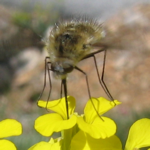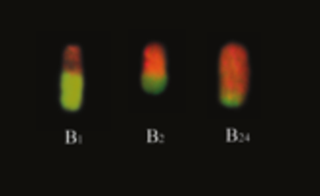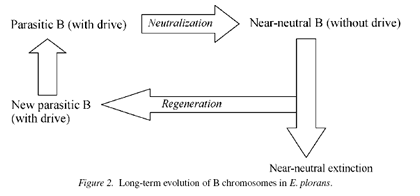Research
Evoflor
Together with ecologist José M. Gómez, botanist Juan Lorite, and zoologist Jordi Bosch, we form the evoflor team. Evoflor is an informal group of scientists with common interests in the evolutionary biology of pollinator and flower shape interactions.

We use an wide range of approaches, including observational and experimental field data, molecular marker analysis, sequence data, greenhouse experiments, and in silico modeling to analyze the diffuse co-evolution between flowers and their pollinators. Our interdisciplinary research is centered in the role of the corolla shape as signal to pollinators. We are using some Brassicaceae species, mainly from the Erysimum genus, as our focal and model species.

Ecological and genetic processes producing speciation: the interplay between hybridization, poliploidy, and local adaptation in generalist plants
The analysis of the processes that generate and maintain species as evolutionarily independent entities is one of the hot research topics in evolutionary biology. In spite of the progress that has taken place over the last decade, the challenge of integrating the different speciation processes remains. It is necessary to analyze how adaptation to local factors, whether abiotic or biotic, interacts with the genetic processes that cause reproductive isolation, particularly under ongoing gene-flow. In the case of the angiosperms, pollinator specialization has been found to be one of the most significant factors for evolutionary diversification. However, the role of pollinators remains unclear in the case of systems with generalist pollination syndromes. The populations of a generalist species can shift their pollination niche by altering the visit frequency of the different pollinators. It is unknown whether these shifts are mediated by independent modification of the same genes or if they are the result of adaptation by introgression. Additionally, other genomic processes can generate new species and contribute to their evolutionary independence. Hybridization and polyploidization are arguably the most relevant of these processes in plants, and are considered to be largely responsible of the angiosperm diversity.
Our starting hypothesis is that phenotypic changes associated with the interaction with pollinators can be involved in speciation even in species with a generalist pollination syndrome. A shift from yellow (typical in genus Erysimum) to purple petals might entail a shift in the relative abundance of the different types of pollinators, and might increase the visit rate of bees, which are highly efficient pollinators. However, these changes do not suffice to ensure reproductive isolation. Hence, other factors such as local adaptation, especially in the earliest ontogenetic stages might have played a relevant role in the radiation and diversification of the genus. Lastly, hybridization and polyploidy would foster and accentuate the differentiation process, inducing speciation. The working hypothesis is that the high rates of speciation of Erysimum are the joint result of all these processes.
To validate these hypotheses, we plan to characterize pollinator preferences and local adaptation with a focus on the early developmental stages between species of this genus that differ in their flower color. We also propose to characterize prezigotic postpollination isolation and ploidy variation in sympatric populations of Erysimum mediohispanicum, E. bastentanum and E. popovii. Lastly, we will use next-gen sequencing techniques to determine the role of hybridization in the history of the studied species. This will enable us to estimate evolutionary divergence among them and to test the hypothesis that flower color has evolved by adaptive introgression.
Structured Generalization: evolutionary
dynamics at fine spatial scales in a generalist system
We called this project STRUGEN or" Structured Generalization: evolutionary dynamics at fine spatial scales in a generalist system". In pollination generalist systems, all plant genotypes in a population are assumed to interact with random subsets of the overall pollinator pool. We think that the generalization degree of a given plant could be non random, but related with some intrinsic and extrinsic factors, such as its microenvironment, its spatial location in the population, and most important, its phenotype and genotype. Plants exhibiting different values for those factors would attract different subset of pollinators, and plants showing different values of those traits would share similar subgroups of pollinators. These inter-individual differences could promote a structured pattern of interaction among the plant and its pollinators, a phenomenon that we call structured generalization. We propose that structured generalization occurs when there are non-random inter-individual differences in generalization and the intraspecific pollination and mating networks at population level are divided in subgroups of plants sharing similar pollinators (i.e., network is clustered).

The main aim of STRUGEN is to explore the occurrence of pollinator-mediated structured generalization, the factors favouring or cancelling it, and their potential evolutionary and functional consequences. Using our previous experience working with the extremely generalist crucifer Erysimum mediohispanicum, we will carry out observational and experimental approaches to evaluate the relative importance of the spatial structure, the micro-environment and the genotype/phenotype in shaping the generalization degree of plants belonging to the same population. We will assess the structure and clustering pattern of the pollination and mating intraspecific networks emerging from those interactions and we will also analyse how individual differences in the degree of generalization affect plant fitnesses.
B-chromosomes
The B-chromosomes, also known as accessory or supernumerary chromosomes, are dispensable chromosomes found in a wide variety of species, from fungus to mammalian animals. These chromosomes usually reduce the fitness of their carriers, thus behaving as genomic parasites. B-chromosomes usually persist in natural populations thank to drive mechanisms that improve their transmission, over-surpassing the Mendelian ratios.

At the Evolutionary Genetic Group at the University of Granada, we are researching the complete life cycle of these parasites, with a special focus on the B-chromosome system of the grasshopper Eyprepocnemis plorans. This grasshopper harbors an extremely widespread polymorphic B-chromosome system, with different B-chromosomes found in almost all circum-Mediterranean and Caucasian populations hitherto sampled.

B chromosomes in this species have been shown to evolve through several stages of parasitic and near-neutral nature, presumably because of an arms race between the standard (A) and B chromosomes. This intragenomic conflict can either be solved with the extinction of the neutralized B chromosome or, more interestingly, with the replacement of this neutralized B-chromosome by a new mutant version, being parasitic again and thus prolonging B chromosome life.
